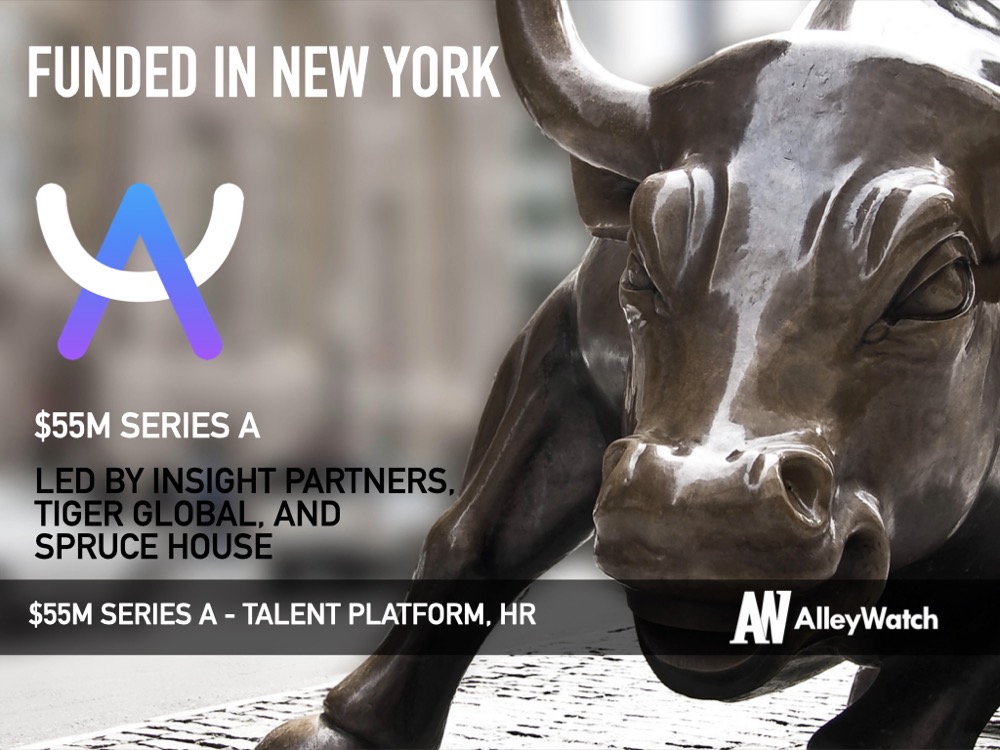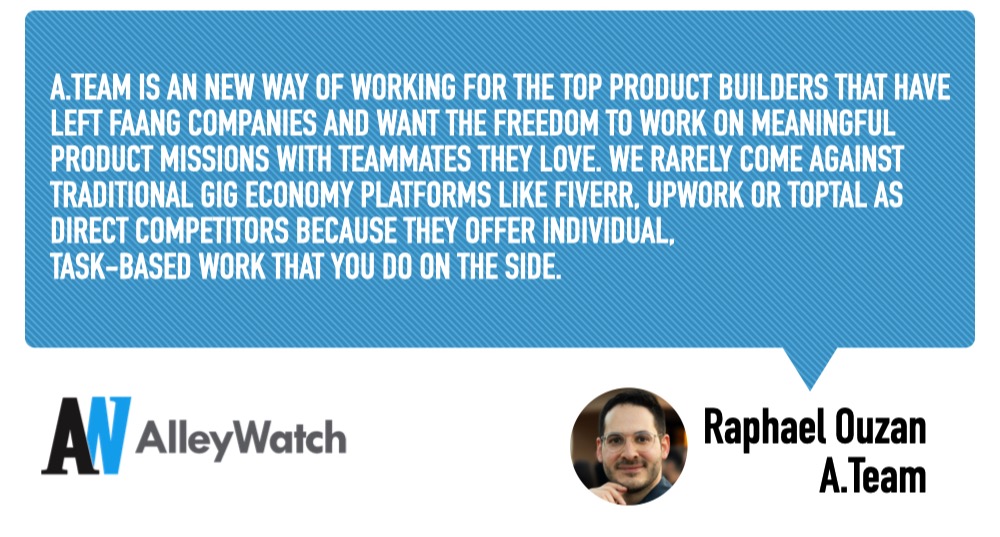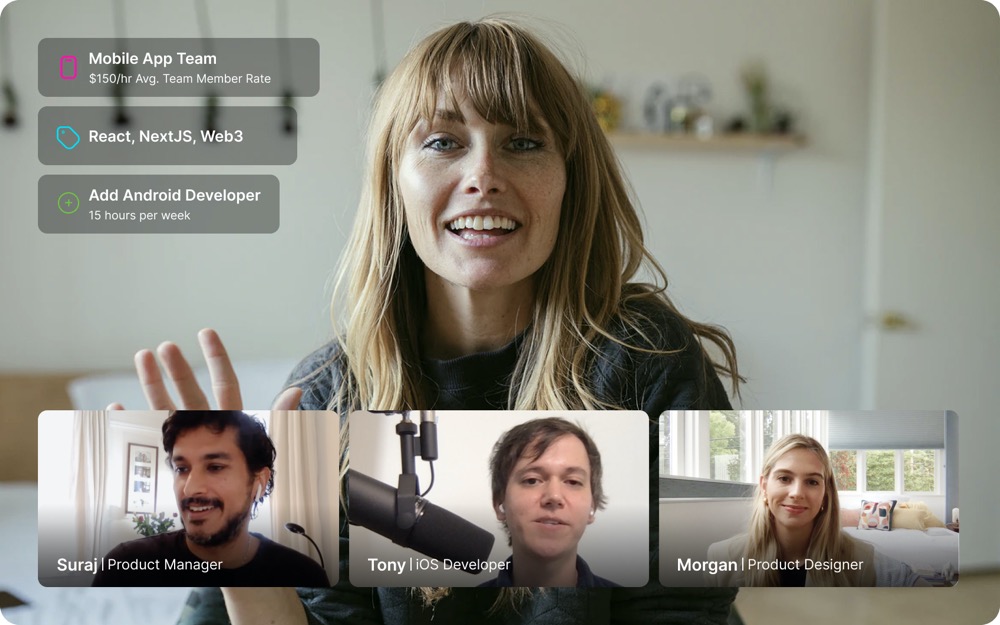Platforms like Upwork and Fiverr have supported the freelance and gig economies, long before the pandemic led to a fundamental shift in how we view work. However, most of the talent and needs on these platforms are for very specific task-based work that lasts a short period of time. Often talent is working on several projects simultaneously. A.Team is a talent formation platform that connects companies to high-skill product building specialists to work on more sustained and meaningful product-focused engagements. The platform features a breadth of engineers, product managers, designers, data scientists, and marketers; over 4000 presently. The talent can opt to work on projects in cohorts with people they know or independently with engagements lasting between 12-19 months on average. Hiring companies are able to access this vetted pool of talent to nearly instantly form specialized teams, saving significant time and resources versus recruiting and hiring independently. As the startup world is milestone-driven, A.Team represents the perfect solution for companies to augment their talent at scale with certainty and achieve their goals. While the company has recently launched publicly out of stealth, it has already provided talent solutions for more than 250 companies since its founding in early 2020.
AlleyWatch caught up with A.Team CEO and Cofounder Raphael Ouzan to learn more about the business, the company’s strategic plans, latest round of funding, and much, much more…
Who were your investors and how much did you raise?
A.Team came out of stealth mode with $60M total funding. This includes a $55M Series A round (more than 4x the size of a typical Series A in 2021) on top of a previously unannounced $5M seed round in 2020. NFX led the seed, joined by Box Group, Village Global, firstminute capital with participation from Adam Grant, Dan Ariely, and the former CEO of Upwork and founder of Fiverr.
Our Series A round was uniquely co-led by three major firms—Insight Partners, Tiger Global, and Spruce House. We’re also backed by future-of-work pioneers like Adam Grant, Dan Ariely, and Joseph Fuller; founders and execs from Lemonade, Upwork, Fiverr, Discord, SpaceX, and Amazon, including Marc Rowan, Cofounder and CEO of Apollo Global Management and cultural leaders like Jay-Z’s RocNation and Michael Ovitz, the founder of CAA.
Tell us about the product or service that A.Team offers.
A.Team is a new model for building teams in the cloud. Our team formation platform empowers our members-only network of 4,000 top product builders (many
ex-FAANG) to team up with their peers to build things they care about with forward-thinking companies—empowering them to build like a unicorn by incorporating elastic product and tech capabilities—whether they’re a traditional tech company or not.
 What inspired the start of A.Team?
What inspired the start of A.Team?
Kobi Matsri and I founded A.Team in early 2020. We saw that highly-skilled tech workers wanted to escape the rigid structures of full-time work, but the gig economy wasn’t an answer for them, since it was so commoditizing and capped with simple, task-based gigs.
Then came the obvious insight: Solving problems that matter requires a team with diverse skill sets, backgrounds, and perspectives. The team is the core unit of work of the knowledge economy, and yet had never been productized in the world of online work. So we started building the world’s first team formation platform to bring world-class product builders together as cloud-based teams, and connect them with companies that have meaningful product missions.
We got our start in the pandemic—companies needed to adapt, and product builders were getting laid off in the tens of thousands. Many of those product builders realized that the stability of full-time employment was an illusion, and teamed up on A.Team to work on problems that mattered to them, while enjoying full autonomy and getting paid well.
The first missions that our A.Teams tackled were to fight COVID—scaling PPE distribution and building contact tracing technology. But then word spread, and companies came along, too. Our first customer, Blank Street, started two years ago this month, using an A.Team to build the future of tech-enabled brick and mortar. Apprentice formed A.Teams to scale vaccine manufacturing software that helped deliver nearly 400 million doses in record time.
A.Team grew rapidly through word-of-mouth, even though we were flying under the radar and had never publicly launched—growing to a members-only network of over 250 clients and 4,000 builders while still in stealth and invite-only. Builders loved the ability to work on meaningful missions, and companies loved the ability to build better, faster, and more flexibly than ever before with expert, cloud-based teams.
How is A.Team different?
A.Team is a new way of working for the top product builders that have left FAANG companies and want the freedom to work on meaningful product missions with teammates they love. We rarely come against traditional gig economy platforms like Fiverr, Upwork, or Toptal as direct competitors because they offer individual, task-based work that you do on the side.
On A.Team, product builders have the freedom to work together on problems that interest them with teammates they love. Those missions last 12-19 months on average, and builders make $130/hr on average. Making $100K a year on Fiverr is the outlier; at A.Team, it’s the starting point.
We also represent a fundamentally new way for companies to build, as well, especially as they now face similar levels of disruption and uncertainty as they did two years ago. Cloud-based teams unlock elastic resourcing for the companies we work with, empowering them to scale product resources up and down based on what they’re building, much like with cloud computing. Think of it like AWS, but for top tech teams.
What people are building with their A.Teams has been incredible to watch, and in fact, we built A.Team with our own A.Teams, so we’ve very much witnessed this power first-hand.
What market does A.Team target and how big is it?
We’re currently empowering hundreds of companies, from early-stage startups, to mid-sized tech and non-tech companies, fast-growing tech unicorns, and large enterprises including F500. While we’re selective with each customer we let into the network, we’re growing these segments significantly.
On the A.Teamer side, we’re welcoming highly skilled product managers, designers, engineers, data scientists, growth marketers, and other types of expertise related to software, hardware, data, and tech development overall.
Our vision is to disrupt traditional talent models and accelerate product development across the tech universe, which is a $5.2 trillion global market. We’ve just scratched the surface, and have ambitious plans for scaling A.Team to disrupt industries beyond tech.
At A.Team we believe that our model is on a path to fundamentally changing how companies build and how people work.
What’s your business model?
A.Team makes money from standard transaction fees.
What are your post-COVID office plans?
A.Team has an office in New York, however, we will never mandate employees to work from it. The BuildTeam—the A.Teams building A.Team—now count over 75 people; half A.Teamers and half FTEs (many of them A.Teamers who decided to join full-time) and is growing rapidly across 10 countries.
A.Team is built on the concept of allowing workers the flexibility and independence to do their best work with autonomy and empowerment in every aspect of their life and throughout the world. Some examples of that include enabling any cluster of A.Teamers to get a budget for an office if they’d like to have a dedicated space to reconvene, travel with their teams for offsite, or meet other team members. Rather than a strict office policy, we invest in “A.Summit”—a recurring offsite for the BuildTeam to meet, play and build for a week in one location. That’s why we were all in Portugal the week before coming out of stealth!
What was the funding process like?
The most meaningful part of the process for us was the time we were not fundraising—our seed investors knew we were doing well a year and a half ago, and our investors were pushing us to fundraise. But we decided not to.
Instead, we started building relationships with VCs —getting to know each other over months and years, and identifying the partners that would go the distance with us.
Before we raised, we wanted to achieve a certain level of predictability and a clear line of sight, so that we had a clear plan on what building a massive multi-billion dollar company would look like. We’ve focused on building a healthy and resilient engine. Thanks to my cofounder Kobi and his modeling superpowers, we could hold ourselves to an unusually high level of discipline in planning our performance and controlling our expenses while growing extremely fast. That’s how we achieve positive cash flow just 14 months after the first A.Team assembled. We knew we were in a world that was incredibly unpredictable, and we had a sense of the type of company we wanted to be—but we also knew that we’d be misunderstood at times. That’s, in part, why we wanted to build the fundamentals of a company that controlled its destiny.
Once we’d built a business that was efficient while still growing revenue 7.4x in 2021, we knew we’d have leverage and optionality in our fundraise, and get to bring on the right partners into our platform to build the broader team to help us cross the chasm from early innovation to a category-defining.
The moment when we pulled the trigger was the moment when had a clearer line of sight to be a $10B company, and we knew we could be there in a matter of years with carefully selected partners. From that point, the deal happened very quickly. We created a mix of capital partners that were bought into the vision, and worked with our seed investors to bring on additional strategic value adds like Adam Grant, Michael Ovitz, Katherine Chen from Amazon, Marc Rowan founder and CEO of Apollo, Brett Johnson from SpaceX, Kevin Hartz, founder of Eventbrite, Allison Baum-Gates from Semper Virens, etc. effectively forming teams with a particular area of strategic focus from Transforming Large Enterprises to Product Growth and Excellence, Brand & Community Building, etc.
What are the biggest challenges that you faced while raising capital?
We needed to evaluate how strategic this investment was for each firm and each partner. We needed to assess how valuable it would be for them from a synergistic perspective, particularly their interest in having their portfolio using A.Team to transform how they built products. It became a sort of litmus test: If you aren’t excited about A.Team for your portfolio, there’s a decent chance you’re not fully bought into the vision of what A.Team can become.
We often learn a lot from working with someone’s portfolio companies—it becomes obvious how exciting a partnership would be. To take an example of a NY-based investor, we were working with companies like Apprentice from Insight Partner’s portfolio for a year before they co-led our Series A, and Jeff Horing in particular has been an incredible visionary who adds so many dimensions to our mission and strategic vision. We’re also very grateful that Jeff chose to join our board of directors.
What factors about your business led your investors to write the check?
A.Team fills a need in the market. Especially over the past year, companies have found it difficult to hire top talent, and we’re bringing it to them. On the talent side of things, there is a growing desire to overhaul the rigid full-time work model, and people are finding that working remotely and independently works for them—especially since stability is not as present and available in full-time employment anymore.
A.Team fills a need in the market. Especially over the past year, companies have found it difficult to hire top talent, and we’re bringing it to them. On the talent side of things, there is a growing desire to overhaul the rigid full-time work model, and people are finding that working remotely and independently works for them—especially since stability is not as present and available in full-time employment anymore.
Our investors share our vision to disrupt traditional talent models and accelerate product development across the tech universe.
What are the milestones you plan to achieve in the next six months?
A.Team has a large number of companies and builders on our waitlist that want to join our network. Our goal is to ramp up to onboard 50 new companies per month.
We’re also making significant investments in our team formation platform to transform the way that companies build, manage, scale, and optimize their teams in the cloud, as well as our TeamGraph technology, which applies skill and experience data with behavioral science to assemble and optimize teams with the optimal skill set for a company’s product mission. We want to unlock the full power of teams, including hybrid teams that mix full-time employees and A.Teamers.
We’re also committed to building the home on the internet for the best product builders. We look at it as building a decentralized company that will share the upside of the network we’re creating with its members —we’ve shared some of these plans with our members-only community, but we’re not quite ready to talk about that yet.
What advice can you offer companies in New York that do not have a fresh injection of capital in the bank?
Everyone is going to tell you to adopt the lean startup model. I’d say forget lean startup—do lean focus. Pick the one thing that if your life was on the line, you would bet on, and then execute those so well—going past the point that most sane people would stop.
What’s your favorite outdoor dining restaurant in NYC?
I do all my meetings at Rosemary’s because they have an amazing business lunch with fresh pasta and a salad.





